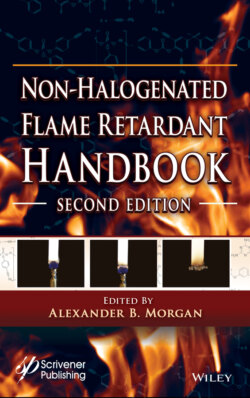Читать книгу Non-halogenated Flame Retardant Handbook - Группа авторов - Страница 30
2.1 Introduction
ОглавлениеIt is generally accepted that the most efficient flame retardants provide their action both in the condensed and gas phases. Although halogen- and phosphorus-based flame retardants exhibit these two mechanisms of action, the difference is that halogen flame retardants can promote charring of most organic polymers by bromine radicals abstracting hydrogen atoms from polymer chains resulting in formation of double bonds or cross-links [1]. Phosphorus flame retardants are more specific to the polymer chemistry than halogen ones and they are mostly effective in the oxygen- or nitrogen-containing polymers due to the fact they need to react with the polymer e.g., phosphorylate it and thus involve it in the charring. The char impedes the heat flux to the polymer surface and retards diffusion of the volatile pyrolysis products to the flame.
If conditions are right, the phosphorus-based molecules or fragments can volatilize and be oxidized producing active moieties in the flame. Volatile phosphorus compounds can be as effective as halogen radicals in the flame, but even here phosphorus surprisingly works well only in heteroatomic polymers. It has always been challenging to design phosphorus-based flame retardants, which will volatilize into the flame at relatively low temperatures and at the same time will not be lost during polymer processing. Therefore, there are not many commercial phosphorus-based flame retardants that provide mostly gas phase action.
The author of this chapter has published a similar chapter on phosphorus-based flame retardants in the first edition of this handbook [2] and he also co-authored two earlier reviews on phosphorus-based flame retardants [3, 4]. This current chapter is an update and extension of the previous publications. This chapter does not cover the large class of chloroalkyl phosphates since they are not halogen-free, but these products were reviewed previously. Although there is a large body of academic publications and patent literature on new phosphorus flame retardants, this chapter focuses only on flame retardants which, to the best of the author’s knowledge, are in commercial use or in advanced commercial development. A recent review on some commercial phosphorus-based and intumescent flame retardants was published elsewhere [5]. There are also broader non-selective reviews on phosphorus flame retardants [6, 7]. Mechanisms of action of phosphorus flame retardants were recently reviewed by Shartel [8].
